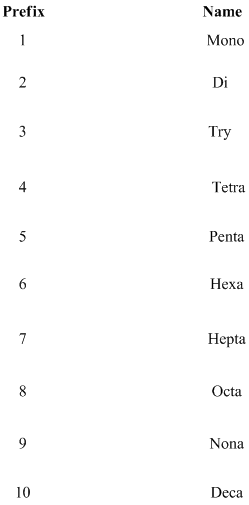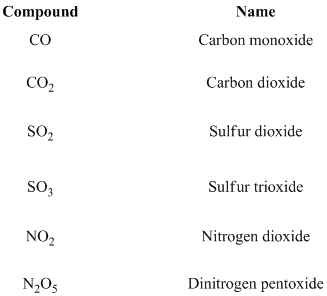
Interpretation:
The name of the molecule should be identified.
Concept introduction:
According to the nomenclature, when two nonmetals are present in the given compound the name of the compound is given as follows, For example, HCl. According to the name of the compound, first give the name for the hydrogen followed by the second element, changing the ending of its name to –ide. Chlorine called as chloride. Therefore HCl is hydrogen chloride. Similarly, HI is hydrogen iodide. SiC is silicon carbide.
One pair of elements to form several different binary molecular compounds. In these cases, using of Greek prefixes to denote the number of atoms of each element present.
Greek prefixes are given below,

If prefix mono substituted is generally omitted for the first element. For example, SO2 is named sulfur dioxide, is not monosulfur dioxide. Moreover, only one atom in a prefix for the first element, no needs to mention mono or di etc. In addition, for ease of pronunciation, we usually eliminate the last letter of a prefix that ends in o or a when naming an oxide. Thus, N2O5 is dinitrogen pentoxide, rather than dinitrogen pentaoxide.

If any halogens are present in the molecule in suffix, the name of the halogens as follows.

Want to see the full answer?
Check out a sample textbook solution
Chapter 5 Solutions
Chemistry: Atoms First
- 3-58 In Section 2-3B, we saw that there are seven diatomic elements. (a) Draw Lewis structures for each of these diatomic elements. (b) Which diatomic elements are gases at room temperature? Which are liquids? Which are solids?arrow_forwardWhat is the name of the compound with formula, Mg(ClO2)2.6H2O ? The answer is ……………………………arrow_forward2 Which of the following gives the formula for aluminum oxide? Group of answer choices AlO AlO2 Al2O Al3O2 Al2O3arrow_forward
- What is the effective atomic number(EAN) of the following compound? (42Mo)arrow_forwardAn element E combines with 02 to form an oxide E which is a good conductor of electricity. Answer the following:(i) How many electrons will be present in the outer most shell of E?(ii) Write the formula of the compound formed when it combines with Chlorine.arrow_forwardWhat is the name of the compound with the formula Ba3(PO4)2 ?arrow_forward
- 2-44 Which period(s) in the Periodic Table contain(s) more nonmetals than metals? Which contain(s) more metals than nonmetals?arrow_forward3-27 Answer true or false. (a) For Group lA and Group 2A elements, the name of the ion each forms is simply the name of the element followed by the word ion; for example, Mg is named magnesium ion. (b) W is named hydronium ion, and W is named hydride ion. (c) The nucleus of H consists of one proton and one neutron. (d) Many transition and inner transition elements form more than one positively charged ion. (e) In naming metal cations with two different charges, the suffix-ous refers to the ion with a charge of +1 and _ic refers to the ion with a charge of +2. (f) Fe32 may be named either iron(III) ion or ferric ion. (g) The anion derived from a bromine atom is named bromine ion. (h) The anion derived from an oxygen atom is named oxide ion. (i) HCO3- is named hydrogen carbonate ion. (j) The prefix bi- in the name “bicarbonate” ionindicates that this ion has a charge of 2. (k) The hydrogen phosphate ion has a charge of +1, and the dihydrogen phosphate ion has a charge of +2. (l) The phosphate ion is PO34-. (m) The nitrite ion is NO2, and the nitrate ion is NO3. (n) The carbonate ion is CO, and the hydrogen carbonate ion is HCO3-.arrow_forward
 World of Chemistry, 3rd editionChemistryISBN:9781133109655Author:Steven S. Zumdahl, Susan L. Zumdahl, Donald J. DeCostePublisher:Brooks / Cole / Cengage Learning
World of Chemistry, 3rd editionChemistryISBN:9781133109655Author:Steven S. Zumdahl, Susan L. Zumdahl, Donald J. DeCostePublisher:Brooks / Cole / Cengage Learning Introduction to General, Organic and BiochemistryChemistryISBN:9781285869759Author:Frederick A. Bettelheim, William H. Brown, Mary K. Campbell, Shawn O. Farrell, Omar TorresPublisher:Cengage Learning
Introduction to General, Organic and BiochemistryChemistryISBN:9781285869759Author:Frederick A. Bettelheim, William H. Brown, Mary K. Campbell, Shawn O. Farrell, Omar TorresPublisher:Cengage Learning Chemistry: Principles and PracticeChemistryISBN:9780534420123Author:Daniel L. Reger, Scott R. Goode, David W. Ball, Edward MercerPublisher:Cengage Learning
Chemistry: Principles and PracticeChemistryISBN:9780534420123Author:Daniel L. Reger, Scott R. Goode, David W. Ball, Edward MercerPublisher:Cengage Learning General Chemistry - Standalone book (MindTap Cour...ChemistryISBN:9781305580343Author:Steven D. Gammon, Ebbing, Darrell Ebbing, Steven D., Darrell; Gammon, Darrell Ebbing; Steven D. Gammon, Darrell D.; Gammon, Ebbing; Steven D. Gammon; DarrellPublisher:Cengage Learning
General Chemistry - Standalone book (MindTap Cour...ChemistryISBN:9781305580343Author:Steven D. Gammon, Ebbing, Darrell Ebbing, Steven D., Darrell; Gammon, Darrell Ebbing; Steven D. Gammon, Darrell D.; Gammon, Ebbing; Steven D. Gammon; DarrellPublisher:Cengage Learning Chemistry & Chemical ReactivityChemistryISBN:9781133949640Author:John C. Kotz, Paul M. Treichel, John Townsend, David TreichelPublisher:Cengage Learning
Chemistry & Chemical ReactivityChemistryISBN:9781133949640Author:John C. Kotz, Paul M. Treichel, John Townsend, David TreichelPublisher:Cengage Learning




